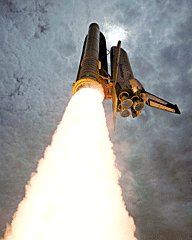January 22, 2006
Intelligence Briefing:
Revolution & Terrorism
The Foam That Ate the Space Shuttle?
Part 3: Target of Terrorists
– Continued from Part 2 –
 |
NASA |
From War Hero to Astronaut: Ilan Ramon |
And on board Columbia, America’s most prominent symbol of technological prowess, was an Israeli astronaut.
Ilan Ramon wasn’t just Israel’s first man in space — itself a profoundly morale-boosting accomplishment for the beleaguered nation — but also happened to be a long-standing hero in the fight against the PLO and Saddam Hussein’s regime. Ramon, an Israeli air force colonel and former squadron commander, flew missions in the 1973 Yom Kippur War and the 1983 war against the PLO in Lebanon. He was one of the elite team of pilots who had carried out the daring 1981 raid that slipped into Iraqi air space, destroyed a Soviet-built nuclear reactor, and effectively ended Saddam’s nuclear program. Ramon had even served as head of acquiring and developing new weapons systems for the Israeli air force, weapons that helped maintain Israel’s superiority over its enemies. And unlike previous American Jewish astronauts, he was the first to honor Jewish religious rules, eating strictly kosher food and honoring the Sabbath.2
The space shuttle was already a prime target; with Ramon on board, it was at dead center of the terrorist bull’s eye. Every leading U.S. agency involved with the Columbia launch, or with fighting terrorism, was explicitly aware of the danger. NASA had already boosted security measures during each shuttle launch since September 11, 2001, and for the Columbia mission, the agency could not deny that security was tighter than ever.3 The U.S. military deployed an unprecedented number of “warships, fighter jets and combat helicopters patrolling the air and sea in a 35-mile perimeter around the ocean-side launchpad,” special-forces commandos personally guarded the astronauts prior to boarding the shuttle, and local police implemented unusually aggressive patrols and searches in nearby Florida communities.4 According to one news report, the protection impressed top, security-conscious Israeli officials: “Security for Thursday’s launch of the space shuttle Columbia, carrying the first Israeli astronaut, is so tight that even the Israelis say they have seen nothing like it.”5
So obvious was the unique threat surrounding Columbia that within minutes of the shuttle’s fiery end, every major federal authority was mobilized to investigate terrorism. A swirl of communications engulfed not only NASA, but the entire Defense Department and the Joint Chiefs of Staff, Homeland Security, the CIA, the FBI, the State Department, and top advisors at the White House.6 It was only when political decisions were passed down that the probe into terrorism was dropped before it could develop.
 |
NASA |
In the Sights: Columbia blastoff |
Despite one sensational press release after another declaring foam the definite culprit, the investigating board itself quietly admitted otherwise. Board Chairman Harold Gehman, Jr., the leading force pushing to blame the foam, conceded, “We are careful not to say the foam knocked a hole in the leading edge of the orbiter, because we can’t prove it”;9 he even agreed that “there is the possibility that foam had nothing to do with it, absolutely.”10
One major possibility the board could never disprove was that something catastrophic happened from inside the spacecraft. A NASA analysis specifically suggested some mysterious explosion could have blown a hole in the shuttle at some point during its fateful mission.11
The official investigating board, not wanting the possibility of terrorism to enter the discussion, steered clear of this explanation. Yet the evidence does back it up:
- The foam hypothesis would predict finding certain melted residues only in the shuttle’s left wing, where the foam piece struck and supposedly opened a hole that would have allowed searingly hot plasma to enter and cause destruction. But investigators were caught off guard at finding the telltale molten aluminum “on a surprisingly large array of debris… the substance has even been found on debris that came from the right side of the craft — far from the area on the wing where the breach is believed to have occurred.”12 A bomb, planted inside the orbiter before launch and detonating sometime during the mission, would explain the aluminum residue found on both sides of the shuttle.
- Also unexplained was the fact that “ many of the space shuttle’s heat-resistant tiles recovered on the ground in Texas are covered with a sooty film that has never been seen before on a space shuttle that has returned safely.”13 A on-board bomb would leave traces of chemicals normally not found on shuttle craft, whereas the foam hypothesis would have more explaining to do.
- Landing gear tires, hidden inside the shuttle’s wings, showed clear signs that they “blew up after some sort of ‘catastrophic event.’”14 The board tried to explain this away as a side-effect of the foam incident, but it may instead reflect an internal explosion.
- Internal wing sensors reported temperature spikes during Columbia’s launch, nearly four minutes after the foam struck the wing.15 The foam was never proven to have breached the wing in the first place, but even if it had, the temperature surge was seemingly too late to be connected with the foam strike. Sabotage, or a bomb detonating during launch, might account for this.
- Alternatively, a concealed explosive could have been rigged to blow while the shuttle was descending. Consistent with this idea, “Columbia suffered some sort of ‘anomaly’ over California. What’s more… the plasma draped over the spacecraft as it raced over California changed colors at one point, suggesting that the craft may have struck an object.”16 Or perhaps an internal explosion.
An onboard bomb would presumably have been set to go off either during ascent at the beginning of the mission, or during descent two weeks later, the two most sensitive periods.
Strong political influences had to step in to divert the investigation away from this evidence. And those same forces had previously crippled national security so much as to make a terror attack on the shuttle feasible in the first place.
References
1. Meyer, J., “Possibility of terrorism is ruled out quickly,” Los Angeles Times, Feb. 2, 2003, p. A16.
2. Dahlburg, J-T. & Hart, L., “Astronaut set to take all of Israel into space with him,” Los Angeles Times, Dec. 21, 2002, p. A10; Meyer, J., Op cit.
3. Dahlburg, J-T. & Hart, L., Op cit.
4. Reuters, “Security extra tight for shuttle launch,” Los Angeles Times, Jan. 15, 2003, p. A11.
5. Ibid.
6. Meyer, J., Op cit.
7. Vartabedian, R., “Report likely to say NASA minimized foam peril,” Los Angeles Times, Aug. 26, 2003, pp. A1, A16.
8. Johnson, J. Jr., “NASA denies claims it’s shading shuttle problems,” Los Angeles Times, April 23, 2005, p. A8.
9. Vartabedian, R., “Near proof of shuttle’s fatal flaw,” Los Angeles Times, May 7, 2003, pp. A1, A19.
10. Gold, S., “Shuttle disaster linked to unseen flaw,” Los Angeles Times, April 16, 2003, p. A18.
11. Gold, S. & Vartabedian, R., “Heat damage found on shuttle wing section may be key clue,” Los Angeles Times, Feb. 28, 2003, p. A23; Gold, S. & Vartabedian, R., “Breach in shuttle suspected,” Los Angeles Times, Feb. 14, 2003, pp. A1, A22.
12. Gold, S. & Anderson, N, “Molten aluminum on debris aids inquiry,” Los Angeles Times, March 5, 2003, p. A20.
13. Ibid.
14. Ibid.
15. Gold, S., “Board nearing judgment on shuttle disaster,” Los Angeles Times, April 23, 2003, p. A15.
16. Gold, S. & Malnic, E., “NASA says tank foam not to blame,” Los Angeles Times, Feb. 6, 2003, pp. A1, A24.